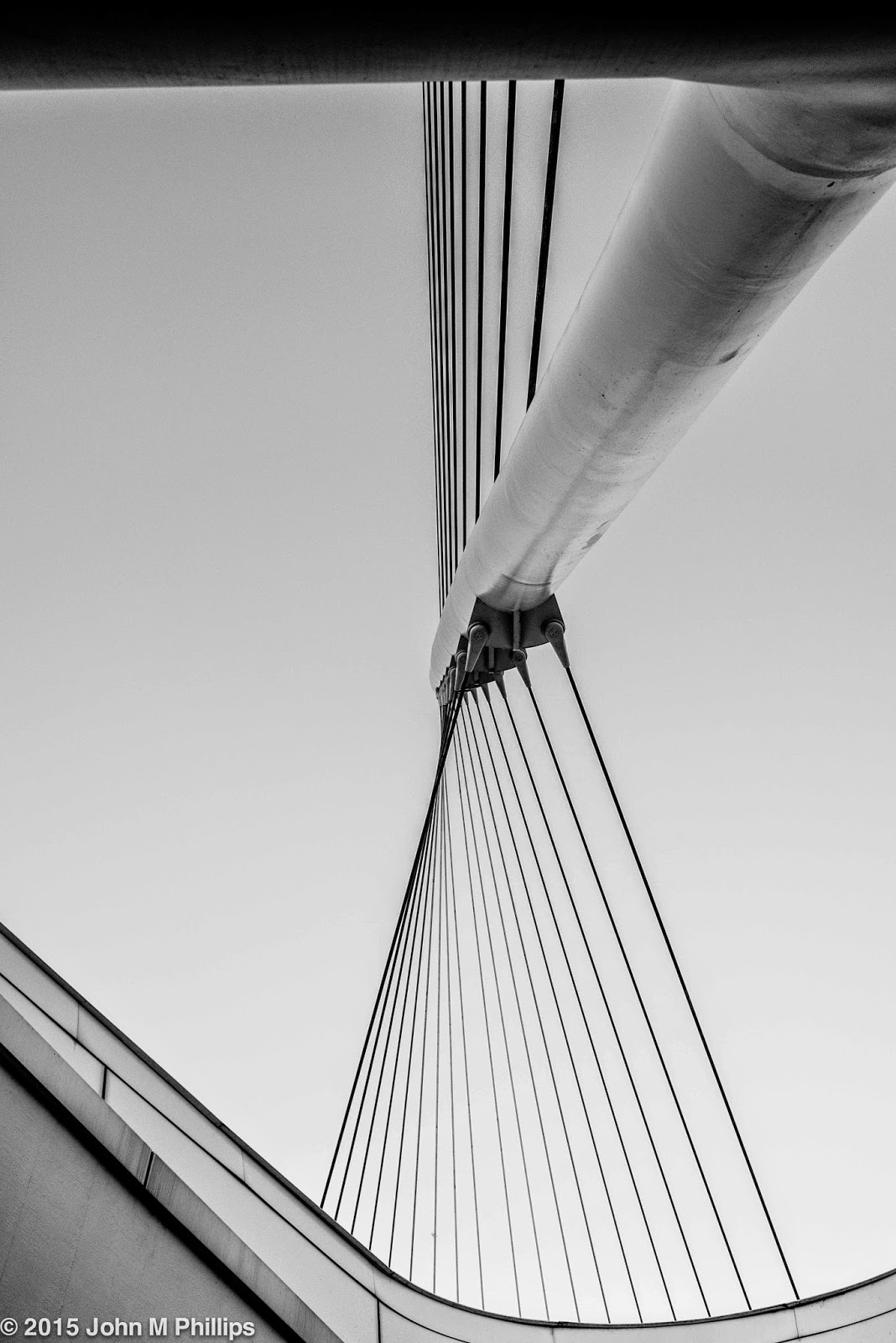Sunday, April 5, 2015
NIGHT AT THE (MILWAUKEE ART) MUSEUM
I returned to the Milwaukee Art Museum last Thursday, not to see the exhibits, which are essentially closed to visitors during an ongoing extended museum expansion project, but because admission is free on the first Thursday of the month and because I wanted to check out how the Calatrava addition would photograph at night.
I actually arrived before sunset and took a few exterior photos handheld while there was still adequate light, including the shot above and the two that follow. I liked the colors in the sky in the above shot, which, for the record, was shot at f/8 for 1/80 second at an ISO of 320.
The moon was nearly full (in fact there was a lunar eclipse the next night), and I wanted to incorporate it in the photo, as in the following shot.
I like the overall shot OK, but incorporating the moon didn't work particularly well. I think it would have been better when the moon was closer to the horizon, but then the sky would have been even lighter. As usual, the moon looked a lot smaller in the photo than it did to the eye. I think this has something to do with the moon illusion. This image was shot at f/8 for 1/40 second at an ISO of 160.
And here is a tighter shot that I converted to a black & white to emphasize the lines in the brise soleil.
Shot at f/8 for 1/125 second at an ISO of 900. Pretty crisp, actually. As a trade-off, it is generally better to accept the increased graininess of a higher ISO, which can be corrected at least to an extent, over motion blur, which cannot.
I usually set my camera on aperture priority, which means that I control the aperture and let the camera decide on shutter speed. However, I have an additional setting on my camera that keeps the shutter speed above a certain level by automatically elevating the ISO. The camera decides on a minimum shutter speed based on the focal length of the shot--the higher the focal length (more telephoto) the shot, the faster the shutter speed needs to be to minimize motion blur. I know, kind of technical.
Before moving inside, I tried to get a couple of artsy shots involving the struts supporting the "mast" extending above the brise soleil. I didn't think the first shot, taken very asymmetrically, worked. It's hard to know what's going on. Note, though, that I did manage to tuck the moon under the tip of the brise soleil.
But I thought the shot below, which I converted to a black & white, worked better, at least as an abstract.
This last was taken at f/8 for 1/50 second at an ISO of 400.
Then I moved inside to shoot the familiar Quadracci pavilion. As sunset was approaching, the amount of available light was substantially reduced, requiring a ratcheting up of the ISO. Here, first, is a relatively bland shot looking east toward Lake Michigan. By this time the sky was becoming a deep blue, which I liked, but, at f/8 and despite a very slow shutter speed of 1/15 second, the ISO was ramped all the way up to 3200.
Because I caught this photo without anyone in the picture, something could be said for it as an abstract. But the problem was a lack of scale. The following asymmetrical shot does a better job of providing people . . . and scale.
This was shot at f/8 for 1/25 second at an ISO of 2000. And here is a shot of the skylight, this time looking west. The extended brise soleil is visible as horizontal bars beyond the skylight windows.
I also took a shot of one of the skylights in the west corridor, again primarily as an abstract. If nothing else, it has an airiness about it.
Taken at f/4 for 1/125 second at an ISO of 160.
Leaving the museum, I took the following shot of the cranes involved in the construction of the new Northwestern Mutual office building a couple of blocks to the west. I thought it worked as an abstract that told something of a story. Shot at f/8 for 1/60 second at an ISO of 3200.
Because of the diminishing light, I ran to my car to retrieve my tripod, which would allow me much longer exposures at much lower ISOs. Here is one last shot of the Calatrava that I particularly liked. Shot at f/8 at an ISO of 400 for a whopping 4.0 seconds.
And finally, a shot looking down Wisconsin Avenue toward the west. The "star" visible in the upper center of the image is actually the planet Venus. Taken at f/8 for 1.3 seconds at an ISO of 400.
I really liked the blue light in the sky at the dying of the dusk.
John
Subscribe to:
Post Comments (Atom)












Hi John, Do you ever license your images? If so could you contact me at daphne@backfinmedia.com
ReplyDelete